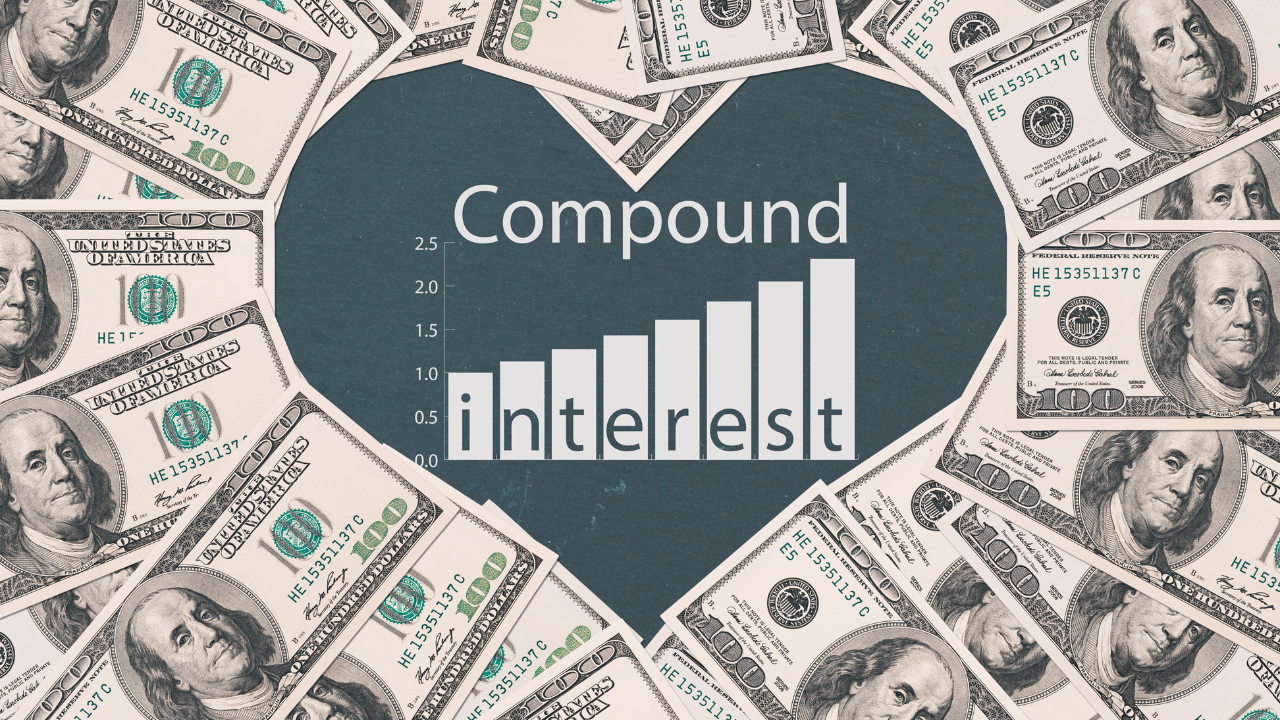Compound Interest: What It Is & How to Earn It
Compound interest is a smart financial tool that can really increase your savings. It’s when the interest you get earns more interest. This makes your money grow exponentially over time if you’re earning compound interest often. Learning about this can help you build wealth over the years1.
It’s like this: the interest you make on your savings, over time, starts making its own interest. This allows your savings to balloon at a faster and faster rate. The impact on your money can be huge1.
Think of it as interest earning money on itself. This process boosts your savings or investments quicker than simple interest would. The more often this happens, the more your money can grow. So, for your financial future, compound interest is a friend that makes your money work harder123.
Key Takeaways
- Compound interest is the interest earned on interest, allowing for exponential growth of your savings or investments over time.
- The more frequently your interest compounds, the faster your money can grow.
- Compound interest can be harnessed through various savings and investment vehicles, such as high-yield savings accounts, CDs, and dividend-paying stocks.
- Starting to save and invest early is key to maximizing the benefits of compound interest.
- Compound interest can work in your favor for savings, but it can also work against you when dealing with debt.
WHAT IS COMPOUND INTEREST? HOW CAN I EARN COMPOUND INTEREST?
Compound interest is an exciting way to grow your money over time. It lets you earn interest on your interest. Each time an interest is calculated, it’s added to the main amount. Then, this new total earns interest in the next period. Thus, your money can grow quickly and really add up over the years4.
This growth isn’t just a little bit; it can be a lot. This is why compound interest is so important for reaching your financial dreams.
Compound Interest Explained
The idea of compound interest is simple: it’s earning money on money you’ve already earned. When you save or invest, each period’s interest becomes part of the main amount. Then, in the next period, you earn interest on that bigger sum5. This cycle keeps going, helping your money grow more and more over time.
How Compound Interest Works
The math behind compound interest is straightforward, too. The magic formula is Compound Interest = [Principal × (1 + Interest Rate/Compounding Periods)^Compounding Periods] – Principal4. Basically, the more often your interest is calculated, the faster your money grows. Also, a higher interest rate means your money grows even faster.
Let’s use an example. Say you put $10,000 in an account with 5% interest, compounded daily. After one year, you’d have $10,512.67. Leave it for another year, and now you have $11,051.63. In just two years, the interest alone is more than $50. That’s the power of compound interest5.
“Compound interest is the eighth wonder of the world. He who understands it, earns it … he who doesn’t … pays it.” – Albert Einstein
To use compound interest to your advantage, start saving and investing early. The more time your money has to grow, the better. They say time helps the extraordinary and hurts the average4. So, start as soon as you can.
 The Power of Compounding
The Power of Compounding
Compound interest helps your money grow quickly over time. It’s different from simple interest. Compound interest adds interest to your savings and the interest you’ve already earned6. This means your money can grow faster as time goes on. It leads to big wealth gains.
Calculating Compound Interest
To find compound interest, use the formula A = P(1 + r/n)^(nt). Here, A is the final amount, P is the principal, r is the annual interest rate, n is how often interest is calculated, and t is the time in years7. By plugging in these numbers, you can see how your money will grow.
The Rule of 72
The “Rule of 72” helps guess when your money will double from interest6. To use it, divide 72 by your interest rate. The answer is how many years it takes to double. So, with a 6% rate, it takes about 12 years to double your money (72 ÷ 6 = 12).
Starting early with compounding can make a big difference687. Putting even small amounts into tax-advantaged accounts like IRAs can lead to a lot more savings over time. That’s because of how fast compound interest grows your money.
I suggest watching the following YouTube video on the topic. The creator provides an excellent explanation of how to calculate compound interest and its mechanisms. You can find the link in the reference section below.
Understanding these simple concepts can help you make smarter money choices768. Using compounding wisely can push you closer to your financial dreams in the long run.
Compounding Periods and Frequency
Compounding means earning interest on interest9. When interest is compounded more often, the total grows faster. The timing of adding this interest to the principal amount is called the compounding period9. This can happen daily, monthly, or even yearly9.
How often interest is added can greatly affect any investment’s growth over time10. Imagine a $1 million investment growing by 20% per year. With yearly compounding, it becomes $1,200,000. Using quarterly compounding, it turns into $1,215,506. The amount is even higher, $1,221,336, with daily compounding10.
The power of compounding is clear in the “rice and chessboard” story10. If the reward doubles on each square of the chessboard, by the last square, the amount is huge. Over 536 million grains of rice would be on that last square. This shows how compounding can lead to big gains over time.
Compounding affects different financial tools, such as savings accounts and bonds11. The way interest is added influences the outcome greatly9. For example, $5,000 at 7% interest becomes $5,724.50 after two years with annual compounding. Yet, it grows to $5,735.75 with quarterly compounding11.
The Rule of 72 is a handy method for doubling an investment with a given interest rate9. With this rule, an investment at 5% interest would double in about 14 years and 5 months10.
To wrap up, how and when interest is compounded can heavily impact the growth of money over time9. Knowing about compounding and its use can guide financial choices. It can help in making the most out of building wealth over the long term9.
Start Saving Early for Maximum Benefit
The key to growing your money is to start early. With time, even a little cash can turn into a lot thanks to compound interest. Starting to save early and staying loyal to it can turn a small amount into a big one.12 This is because compound interest speeds up how fast your money grows over time13 leading to major financial advantages later on.
Let’s use some examples to show the power of starting early. Say you put $3,000 in a bank at a 2% interest rate that’s compounded yearly. After 40 years, you’d have $6,62514. But if that interest was compounded monthly, you’d have $6,67314. The monthly difference might seem small, but it shows how often your interest is added can boost your overall earnings.
Now, let’s compare three investors putting $1,000 a month away. All at a 1.5% interest rate for 10 years13. The one who began at 25 would have $203,105 by 65. The 35-year-old would have $174,831. And the 45-year-old just $150,49213. Starting early makes a big difference because of compound interest13.
By starting early141213, small contributions like $25-$100 a month can grow significantly over time due to compound interest. Compound interest builds wealth faster with regular deposits13. Starting early lets you use compounding141213 to make a lot of money throughout your life141213.
Advantages of Compound Interest
Compound interest is a great way to boost your wealth over time. It uses the power of compounding to grow your savings and investments. This helps you beat inflation and increase your money’s value9.
One big benefit is how it grows your money fast. When your returns start earning returns, you get a snowball effect. This leads to your money growing much more9. It’s best for long-term investments because time boosts your earnings through compounding.
Compound interest is your friend also when paying off loans. Using compounding, you can lessen the total interest on the loan. This means you end up spending less money over the loan’s life15.
It’s also good at fighting off inflation. As your savings and investments grow, they keep up better with the rising prices of things. This protects your financial future against the harm of inflation9.
Lastly, it can work with different financial tools like savings accounts or investment funds. Choosing products with good compounding rates can magnify its benefits. This way, you get more out of compounding15.
In the end, compound interest offers many perks. It speeds up how you grow your money and guards it against inflation. Knowing how to use compounding can help you build a wealthier future. It’s a key tool for achieving financial success16.
Disadvantages of Compound Interest
Compound interest can boost your savings significantly. But, it can be a big problem if you have high-interest debt. This is often the case with credit card balances17. If you leave a balance on your card, the interest grows fast. This makes it hard to lower your debt and get out of the “debt cycle.”17.
Another downside is that you have to pay taxes on the interest earned18. And, it’s more complicated to figure out than simple interest. Understanding these finance matters can help you make the most of your money18.
Risks of Compounding on Debt
Compounding debt interest can really hurt your finances17. As your debt grows, so do the minimum payments. It gets harder to pay off what you owe17. This can put you in a never-ending debt cycle. It feels like you’re only paying off the interest but not the actual debt.
People with lower incomes or who don’t know much about finance can be hit even harder by this19. For instance, a $10,000 debt at 18% annual interest will be over $43,000 in 30 years19. With simple interest, it would be just $25,00019.
To sidestep compound interest issues, focus on clearing high-interest debts quickly. Look for loans or credit cards with lower interest rates to save money in the long run171819.
Compound Interest in Investing
Using compound interest can make investments grow faster. Two big ways to do this are through dividend reinvestment plans (DRIPs) and zero-coupon bonds20.
Dividend Reinvestment Plans (DRIPs)
DRIPs let investors automatically buy more of a stock with their dividends. This way, the dividends themselves help buy more shares, earning extra over time20. Reinvesting dividends steadily can boost how much money you make from your investment in the long run.
Zero-Coupon Bonds
Zero-coupon bonds work on a similar idea but with bonds. You buy them cheaper, and they slowly grow to their full value20. Since there are no smaller payments, the whole amount can grow a lot by the time it matures.
For investors, compound interest is key for making their portfolio grow swiftly. With DRIPs and zero-coupon bonds, they can make more in the long run202122.
“Compound interest is the eighth wonder of the world. He who understands it, earns it; he who doesn’t, pays it.” – Albert Einstein
Tools for Calculating Compound Interest
Using Microsoft Excel
Calculating compound interest is easy with Microsoft Excel’s features. This spreadsheet program has tools that show how compound interest works. You can test different situations easily23.
In Excel, the common way to calculate is by the multiplication method. You multiply the new balance for each year by the interest rate. This shows how compound interest increases over time. You can change the principal, interest rate, or how often it compounds to see their effects on your investment23.
Excel has functions like FV and RATE. These functions make compound interest calculations simpler. Just enter the details like the first investment, the rate, and when it compounds. Then Excel shows you the future worth of the investment or how effective the interest rate is24.
To make Excel even better at compound interest, you can use different formulas. For example, the formula A = P(1 + r/n)^(nt) is one you can use. Here, A is the final amount, P is the initial amount, r is the yearly interest rate, n is how regular the interest is added, and t is the time in years. These formulas help you calculate compound interest accurately24.
With all these tools in Microsoft Excel, you can work out, see, and test compound interest. This helps you make choices that grow your money wisely. It’s great for your financial future232425.
| Calculation | Outcome |
|---|---|
| Initial investment: $10,000 Interest rate: 5% annually Compounding period: Annually Investment period: 10 years |
Total value after 10 years: $ 16,288.9523 |
| Initial investment: $100,000 Interest rate: 12% annually Compounding period: Annually Investment period: 5 years |
Total value after 5 years: $176,23423 |
“Compound interest takes into account interest on interest, leading to overall higher returns.”23
Excel makes it simple to understand and utilize compound interest. It helps you think smartly about your financial plans for the future232425.
Impact of Interest Rates and Compounding Frequency
The interest rate and how often it’s added (compounding frequency) impact compound interest’s power. Higher interest rates and more frequent compounding make your money grow quicker. They use the magic of compound interest26. Adding more interest or compounding more often boost your savings rapidly26.
Interest rates greatly affect how much your money grows26. For example, 1 percent interest yearly on $1,000 gives you $10 after a year26. If you have $100,000 earning 2 percent yearly, after 30 years it becomes $181,136.16 with yearly compounding. With daily compounding, it turns into $182,208.8826. At 5 percent, after 30 years, you end up with $432,194.24 annually and $448,122.87 daily26.
How often interest is added also heavily influences your savings27. Unlike simple interest, compound interest helps money grow much faster27. Interest can compound annually, semi-annually, quarterly, or even daily. These options impact how much your investment grows27. For instance, $1,000 at 5 percent annually becomes $1,628.89 in ten years. The more frequent the compounding, the more you earn over time28.
Knowing how interest rates and compounding affect savings is key28. You should always check the annual percentage yield (APY) to understand the real interest rate. This tells you how much you can make through compound interest26. How often the interest is added also matters. More frequent additions can give you bigger returns on your money than less often compounding26.
“Compound interest is the eighth wonder of the world. He who understands it, earns it… he who doesn’t… pays it.” – Albert Einstein
Using higher interest rates and frequent compounding can really make your savings soar. It shows the true strength of compound interest over the years262728.
Conclusion
Compound interest is a key financial idea that can really make a difference in your savings and investments. Understanding compound interest is crucial, as is starting to save early. It’s also important to note how interest rates and how often interest is calculated matter.
Imagine doubling a penny every day for a month. You’d end up with $10,737,418 by the end of the month. This is much more than if you got $10,000 every day, which only adds up to $310,000. The example shows how important time, interest rates, and adding more money are in growing your savings29.
Being early to start makes a big difference when investing30. The higher the interest rate is, the more you’ll earn. Plus, the longer your money grows, the more you’ll have in the end29. This proves that compound interest is a path to real financial growth over time31.
Using these ideas in your financial plans, you can unlock the power of compound interest. This will help you make big steps towards your financial dreams over time.
FAQ
What is compound interest?
Compound interest is like free money that grows more over time. Imagine your money is a plant. As it grows, it gives off seeds. And then those seeds plant new money plants.
How does compound interest work?
It’s simple. Compound interest makes money from money. The more often your money makes money, the faster it grows. This is why starting to save early is so powerful.
What is the formula for calculating compound interest?
The formula goes like this: Compound interest equals your principal (P) times one plus the interest rate (i) to the power of the number of years (n). Subtract the principal at the end.
What are compounding periods?
These are times when your account gets a boost of interest. It can happen yearly, every six months, or even every day. The more often, the better for your savings.
Why is starting to save early important for compound interest?
If you begin saving when you’re young, you’ll have more time for your money to compound. This means even small savings can grow a lot. It’s more effective than saving a lot later on.
What are the advantages of compound interest?
Compound interest grows your money on its own. It helps beat inflation. Over time, it can make a big difference in how much you end up with.
What are the disadvantages of compound interest?
Unfortunately, compound interest isn’t always good. It can make debts grow fast. This happens if you only pay the smallest amount on high-interest debts.
How can investors take advantage of compound interest?
Investors should look into dividend reinvestment plans and zero-coupon bonds for compounding. Both methods let you reinvest money to make more money over time.
What tools can help calculate compound interest?
Microsoft Excel is a great tool for this. You can track how your money grows year by year. It’s helpful for seeing compound interest in action.
How do interest rates and compounding frequency impact compound interest?
Simply put, higher rates and more often interest addition mean your money will grow faster. So, choose investments carefully for the best results.
Fair Use Statement
Disclaimer:
The topics discussed in this blog are for educational and informational purposes only. They do not constitute formal advice to act upon in any way. Readers should consult with a qualified professional before making any decisions or taking any actions based on the information provided. The author and the blog are not liable for any consequences resulting from the use or reliance on the information presented.
Source Links
- https://www.investopedia.com/how-to-open-a-compound-interest-account-7505889 – How to Open a Compound Interest Account in 2024
- https://www.experian.com/blogs/ask-experian/best-compound-interest-investments/ – Best Compound Interest Investments – Experian
- https://www.fool.com/investing/how-to-invest/stocks/compound-interest-accounts/ – Which Accounts Earn Compound Interest? | The Motley Fool
- https://www.bankrate.com/investing/best-compound-interest-investments/ – Best Compound Interest Investments | Bankrate
- https://www.nerdwallet.com/calculator/compound-interest-calculator – Compound Interest Calculator – NerdWallet
- https://www.bankhillsboro.com/the-power-of-compound-interest/ – The Power of Compound Interest: Making Your Money Work Harder for You | Bank of Hillsboro
- https://tcgservices.com/2023/09/12/the-power-of-compound-interest/ – The Power of Compound Interest: How Your Money Can Multiply Itself | TCG, a HUB International Company
- https://srfs.upenn.edu/financial-wellness/blog/power-compound-interest – The Power of Compound Interest
- https://www.investopedia.com/terms/c/compoundinterest.asp – The Power of Compound Interest: Calculations and Examples
- https://www.investopedia.com/terms/c/compounding.asp – Compounding Interest: Formulas and Examples
- https://tpfcu.com/blog/what-is-compound-interest/ – What Is Compound Interest? – The People’s Federal Credit Union
- https://windgatewealth.com/the-power-of-compound-interest-and-why-it-pays-to-start-saving-now/ – The Power of Compound Interest and Why It Pays to Start Saving Now – Windgate Wealth Management
- https://www.bankalgonquin.com/small-business/resources/financial-education/2021/09/the-power-of-compound-interest.html – The power of compound interest
- https://fortune.com/recommends/banking/what-is-compound-interest/ – Understanding compound interest can help you grow wealth
- https://www.time.com/personal-finance/article/what-is-compound-interest/ – What Is Compound Interest?
- https://www.centralbank.net/learning-center/what-is-compound-interest-and-why-its-important/ – What is Compound Interest and Why it’s Important
- https://www.thrivent.com/insights/investing/simple-vs-compound-interest-explained – Simple vs. compound interest explained: Differences, pros & cons
- https://time.com/personal-finance/article/what-is-compound-interest/ – What Is Compound Interest?
- https://www.dividend.com/my-money/the-pros-and-cons-of-compound-interest/ – Dividend.com
- https://www.fidelity.com/learning-center/trading-investing/compound-interest – What is compound interest? | Fidelity
- https://www.schwab.com/learn/story/power-long-term-compound-interest-investments – Power of Long-Term Compound Interest Investments
- https://www.forbes.com/advisor/investing/compound-interest/ – The Life-Changing Magic Of Compound Interest
- https://www.hdfclife.com/financial-tools-calculators/compound-interest-calculator – Compound Interest Calculator
- https://www.calculatorsoup.com/calculators/financial/compound-interest-calculator.php – Compound Interest Calculator
- https://www.etmoney.com/tools-and-calculators/compound-interest-calculator – Compound Interest Calculator Online- Daily, Monthly, Quaterly & Yearly
- https://www.bankrate.com/banking/what-is-compound-interest/ – What Is Compound Interest? | Bankrate
- https://www.fidelity.ca/en/insights/articles/what-is-compound-interest/ – What Is compound interest? how it works, benefits, and how to calculate
- https://www.northstarfinancial.com/news-events/compound-interest-what-it-is-and-how-it-works/ – Compound Interest: What it is and how it works
- https://napkinfinance.com/napkin/compound-interest-definition/ – What is Compound Interest? – Napkin Finance
- https://slavic401k.com/compound-interest-examples-for-different-ages/ – The Power of Compound Interest: Examples for Different Ages – Slavic401k
- https://diversifiedllc.com/article/what-is-compound-interest/ – What is Compound Interest and How Does it Work? – Diversified LLC
- https://youtu.be/P182Abv3fOk– Compound Interest Formula Explained, Investment, Monthly & Continuously, Word Problems, Algebra




